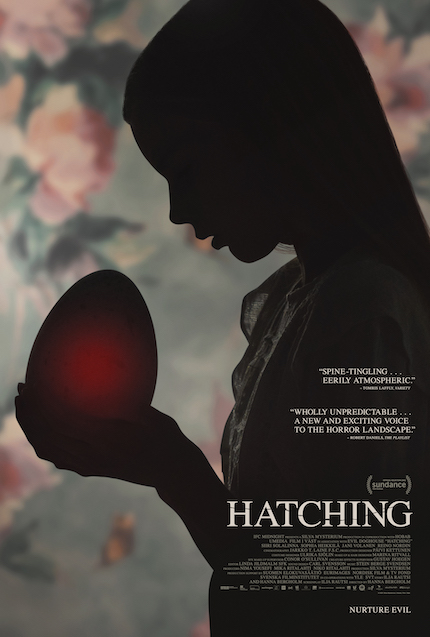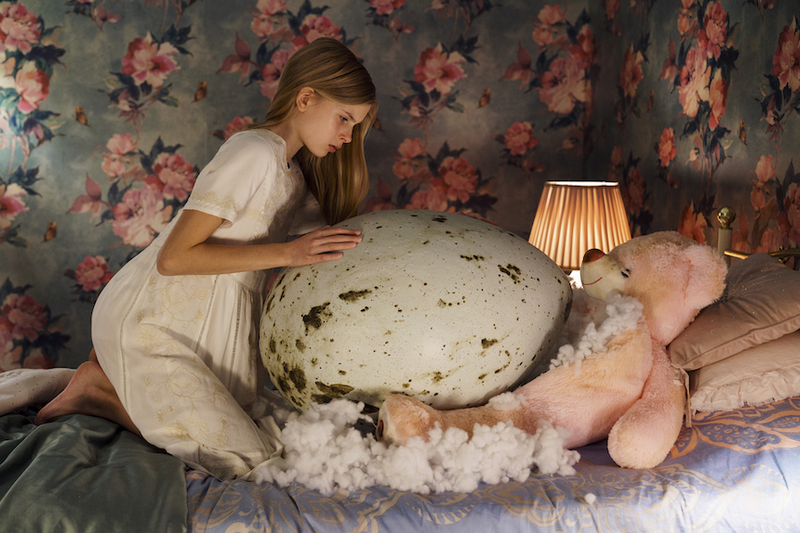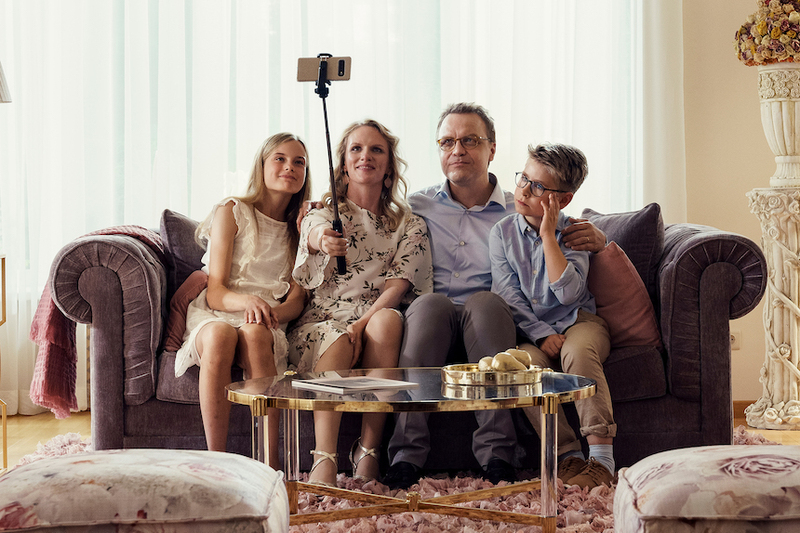Interview: HATCHING Director Hanna Bergholm on Her Coming-of-Age Creature Feature

Hatching, the debut feature by Finnish director Hanna Bergholm, is a horror film that stands out for its creature feature and coming-of-age elements. The protagonist Tinja (Siiri Solalinna) is a teenager who lives with her mother (Sophia Heikkilä), her father (Jani Volanen) and her brother (Oiva Ollila). They all participate in the vlogs recorded by the mom, sharing their perfect life in the suburbs. A sequence at the beginning, when a black bird bursts into the family home causing havoc – it is caught and the mother breaks its neck mercilessly – shows a hint of the dark side that underlies a seemingly ideal family.
Tinja practices gymnastics but her mother, an extremely strict and inconsiderate former figure skater, asks her to prioritize training above all else, including socializing with other teenagers. The mother, in fact, has an affair with another man (Reino Nordin) and gradually involves Tinja more in this new life. In the mother's mind none of this should affect in the least her daughter's performance towards a competition.
Hatching develops its fantastic element once Tinja finds the dying bird and, after compassionately finishing it off, discovers an egg that she decides to take care of. The creature made remarkably with practical effects, is at the same time grotesque, dangerous and vulnerable. It’s essentially Tinja's baby, with whom it has a very special connection that will evolve into a doppelgänger whose violent actions are usually a consequence of the maternal yoke to which the protagonist is subjected.
After premiering at the Sundance Film Festival, as part of the Midnight section, Hatching hit theaters in the United States on April 29 and will be available on VOD starting May 17. On the occasion of this release, below is a conversation with its director.
ScreenAnarchy: What inspired you to make a horror movie with a creature?
Hanna Bergholm: Everything started with our screenwriter (Ilja Rautsi) having an idea that a child hatches a doppelgänger out of a bird’s egg. Birds are very fragile animals, they fly free and they hatch their eggs and their babies, so it fit very well for our story to be a bird. Actually in old Finnish mythology called Kalevala, the whole world is created from a bird’s egg; we didn’t actually think about that so much when we were writing the script but it’s just a little nice detail.
During the development, some of the films I watched and really loved were Raw and the old David Cronenberg films like The Brood and The Fly, I really admired their practical effects and I wanted to have the same kind of rawness for our creature. The Swedish film Let the Right One In has both drama and horror elements in it. Also we discussed that our film is kind of like a twisted E.T. The Extra-Terrestrial for grown-ups. Those were films that came to my mind when planning this one, even though they weren’t direct references. I tend to avoid thinking about other films when I plan a story and the style of a film.
Why did you decide to use practical effects?
I really wanted our creature to have a real physical presence, I didn’t want it to be just a digital character, I wanted a feeling that you can really touch this creature. Then we designed the look of the creature in Finland with two wonderful concept artists. I knew that I wanted it to be an animatronic puppet, so then I actually Google that: who is the best animatronic designer in the world? Google told me that that is Gustav Hoegen, who has been the lead animatronic designer in Star Wars, Jurassic World: Fallen Kingdom and Prometheus, so I contacted him and he got excited about this film, came on board and collected a wonderful team that created this creature for us.
When the creature is still a baby, it can act brutally to defend the girl. It's horror – even grotesque – and at the same time the connection between them is emotive.
When we planned the script it was very important for us not to tell about a monster that is an evil character. The monster represents the girl’s hidden emotions, also her sorrow, her need for love, and those aren important feelings as well, therefore it’s important that this creature is not just some evil predator.
When we started to design the look of the creature, I was describing a smelly teenager that is raging to its parents and still wants to be loved. It’s totally deformed and disgusting so it’s totally opposite of this perfect gymnast girl. I wanted it to have very big eyes so it’s kind of very innocent looking and looks like it has all its instincts open.
With the evolution of the creature, the film speaks about duality, about how humans aren’t perfect.
It was important to tell about how if you try to control everything and try to keep everything perfect, whatever it means, you can’t actually achieve that, it would mean that you would have to hide some elements of your character and some of your emotions, and in the end that’s not possible. You really have to face all your flaws in order to be loved fully as you are, you have to let people to see you as you are with all your flaws and scars.
What do you think of those fictitious lives that are created on social media?
In our story this mother tries to keep up appearances of happiness and, maybe, she tries to find happiness for herself by pretending this wonderful, perfect look of her life. In one way or another many people are doing it nowadays through social media, I think it’s only human: if we take a picture of us, we want to take out the piles of laundry behind us. It has become a way of belonging into a group, everybody tells the same message on social media that “my life is wonderful, everything is so fine with our family.” I wanted to have that in our film because it is a bit of a strange way of communicating, but it’s quite human, many of us do it as well.
How did the relationship between mother and daughter and the emphasis on the world of gymnastics come about?
Ilja Rautsi, our screenwriter, wanted the girl to have some hobby that is competitive, where it’s important to be physically perfect. Ilja was a gymnast when he was a kid, but he liked the sport actually. So we also wanted to portray that the sport itself is not harmful: the coach is quite nice and it seems like the other girls are having fun. But for Tinja, it’s all her mother, who really wants to fulfill her dreams through her daughter, and wants to push her daughter to be the best but nothing the girl does is never enough for the mother. It’s not really Tinja’s passion to do this sport.
I really wanted to explore this twisted mother-daughter relationship, where the mother treats her daughter as the daughter would be something that belongs to her and is there to fulfill her dreams. I think that’s very horrifying, that’s where the biggest horror in the film lies.
A version in Spanish of this interview was also published at Cinema Inferno









